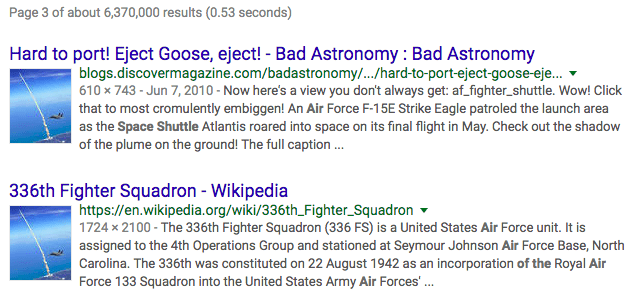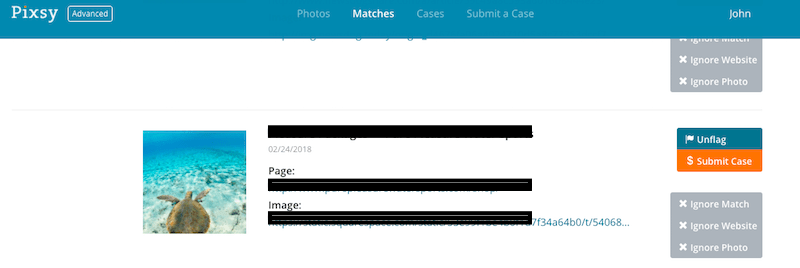Disclosure: This post may contain affiliate links. I earn a small commission of product sales to keep this website going.
It started with a reverse Google image search – just where was my legendary space shuttle launch photo these days? Turns out it’s in over 6 million places online. And I can’t pursue a single penny because I made the photo during my service as a government employee and the photo is in the public domain.
Oh well. Which other photos of mine might be used elsewhere without permission? I grabbed another popular photo in my portfolio and was shocked to see over a dozen unauthorized uses, including some commercial use. I repeated the process with a couple more photos, finding even more thieves. This was going to take forever.
Photograph copyright protection services
Then I read an extremely relevant and timely article in Fast Company. It just miraculously popped up in my Facebook feed as I was taking a break from the reverse image search. Still think Facebook isn’t watching you?
Anyways, the article outlined some services that can do all of this for you, starting from scanning your whole portfolio and seeing it all the way through legal resolutions. They take a decent cut of the settlements, but it’d be worth it considering the headache it’d save me. Access to their technology and legal expertise? I’d still get some money out of it where I probably otherwise wouldn’t.
I signed up for Pixsy, sent them to my portfolio, and they immediately had hundreds of matches for me. It was like opening up Pandora’s Box.
Pixsy allows you to go through these matches and either ignore them, ignore a specific photo altogether, send for takedown, and send for compensation.
Most of the matches were suspected “non-commercial” use, bloggers and content scrapers. But there were still a number of commercial uses. Out of those commercial uses, most of those were still “little fish”, mom-and-pop tours and things of that nature.

I thought about making this company wear the scarlet letter, but I don’t need any more trouble so I redacted their info. Anyways, this is what Pixsy looks like.
Dealing with small commercial services
I immediately sent invoices to the little guys.
I used standard licensing fees and emailed an invoice with payment instructions and the license. After a week of no responses, I sent a polite followup email reminding them to pay for the license.
Guesses on how many paid? Two, out of eighteen I decided to pursue. I guess I should be lucky the number is this high. One of those only paid when they were CC’d on my abuse complaint notice to GoDaddy a month later. The other paid immediately upon receiving my invoice; they’re a tourism authority with an island I have strong ties to. They had contracted out their web design work (to another photographer who has “copyright” plastered all over his portfolio, go figure), unaware of the transgression.
Two additional perps responded to me; one said he contracted out his web design to someone else and apologized, removing the photo. The second cited Fair Use and we’ll get to that in a minute.
Most others just took the image down without saying a word to me or paying a dime. A few completely ignored me, and I elevated those to Pixsy’s team.
If they’re not going to properly acquire the image in the first place, odds are they aren’t going to retroactively pay for it upon receiving an email from the photographer.
Dealing with bloggers
I sent some polite, informative letters to the bloggers, asking them to replace what they had with what I would provide.
My problem isn’t that they didn’t ask to use a photo. The problem is that they somehow had the full-resolution image available for download, probably screen-grabbed before I started watermarking with a signature, and didn’t realize the implications that had.
If a blogger wants to use a small, low-res thumbnail, and link that back to the full-res photo on my portfolio, that’s fine. I gave them instructions for doing so. At least thieves would be stealing my photo from me, instead of stealing my photo from someone else, further undercutting my ability to make money off of my services.
Surprisingly no one responded to me after my deadline of two weeks. I had to send Digital Millennium Copyright Act (DMCA) takedown notices to their hosting services to have the files forcibly removed. All hosting services complied, and now these folks have “copyright strikes” on their account records and embarrassing “Copyrighted Image” placeholder images until they replace it.
I don’t want to sound like an asshole going after an innocent blogger, but they were giving away to the world something that I sell to others.
How do you send takedown notices and letters to copyright infringers?
I based my email templates loosely on some example letters that noted insect photographer Alex Wild made available to other photographers online. It’s actually a funny read, go check it out and learn about how to write takedown notices and cease-and-desist letters.
If no one responds to you after a few tries, you’ll have to send a takedown, contacting their hosting service directly. If you don’t see anything like “WordPress”, “Squarespace”, “Blogspot”, or some other obvious hosting service in their website footer, you can still find who hosts them. Go to the ICANN WhoIs information and you can find both their registrar and who their nameservers point to. Those companies will often have a form or email address to send abuse complaints to.
Side-note, Alex just recently filed a lawsuit against a pest control company for $2.7M. His lawyer sent a cease-and-desist to this company, which was using ten of his images. The first letter went ignored; the CEO of the company acknowledged the second letter and said he’d “take care of it.” Not only were the images not taken down months later, but Alex discovered that they stole eight more of his photos. Some people just need to learn this lesson the hard way and I hope a judge awards Alex a hefty chunk of his claim. Full article on PetaPixel.
Fair Use
So there was a fellow running a news site about Haiti. Seemed like a nice guy, doing some great things for Haiti. He had used one of my images without permission and without credit. I told him that he’d have to purchase a license if he wanted to make the full-resolution image available on his website. He refused to take down the image and refused to pay a license, citing the Fair Use rule because the article was “news.”
Fair Use states that someone can legally reproduce another person’s work without permission or even give credit, granted it meets four conditions. All four conditions must be met, and you can read more about it here. But the short of it is that you can’t make someone else’s entire, unaltered work available for free if they’re trying to sell it elsewhere.
In this case, he was making the entire full-res photo available for download. Someone who might be inclined to pay me for it would just rather get it from him for free, ruining the potential market value of that photo.
I explained this to him and offered to give him the HTML embed code, letting him use a thumbnail that links back to my website. He just replaced the image entirely and that was the end of that.
Pixsy and the cases I gave to them
Pixsy is still handling the cases I sent to them. I understand it can be a slow process; demand for their services is high and they’re still a small but growing company.
I’ll have an update on this process in hopefully a few months once my first cases are cleared up.
One of the biggest limitations is their inability to pursue cases in many countries in Asia, South America, and Russia. After a few weeks of waiting, they informed me that they couldn’t go after two of the commercial users that I wanted them to go after because of geography. So I was stuck with sending a letter myself, explaining that I owned the photo and how much a license would cost. Surprise, no one wanted to retroactively pay me. One removed the photo and the other made me issue a takedown.
Pixsy does scan both my portfolio and Instagram feed constantly and sends me an email when new matches are found. It’s still a great monitoring service, even if they are limited with what they can pursue and the amount of time it takes.
Lessons learned and future actions on copyright infringers
If I had to do this process all over again I’d probably take human psychology into account some more. At least, my limited understanding of it.
My choice for “first contact” probably should have been a letter introducing myself and explaining what is going on (I see you, the image needs a license, I need to protect my copyright, I’m going to ask you to pay for it). Instead of just outright sending an invoice. Just getting an invoice out of the blue could make someone hit the “mark as spam” button before reading it. Thanks to that damn Nigerian prince. It could also put them much more on the defensive and that doesn’t help me.
My decision to go straight to sending invoices was based on something I heard from another photographer who goes through this process almost weekly. So I don’t know, maybe it can be effective, or maybe an introductory letter would be better. Try both.
For countries other than those in North America, the EU, and the UK (too soon, Brexit?), I don’t think I’ll bother with letters and invoices. I’m just going to go straight to sending takedown notices. Pixsy can do this on your behalf for some of those countries that they can’t take legal action in, but not all.


alybrow
Wednesday 4th of April 2018
Ugh. What a pain. Years ago, I thought all of my photos on SmugMug were protected. Until one day I received a photo book, made for me by my mother as a gift, containing ALL of my photos from a two-week trip I took to Montana. I was grateful it was my mother and not someone else (although I have never searched to see what is out there). Immediately, I went into SmugMug and changed all of my privacy settings. I'm in the process of figuring out how best to release some of my photos into the wild, and to be honest, the whole process is overwhelming and terrifying, especially after reading these posts by you. So thanks. Thanks for scaring me! ;)
maxpatch67
Wednesday 4th of April 2018
Ya it’s both ridiculous and scarey.
John Peltier
Wednesday 4th of April 2018
Oops, that’s not what I meant to do! SmugMug has some great photo protection capabilities, but like anything there are flaws. The only way to prevent this 100% is to not put anything online. But then I’d have to look for a real job again. Thankfully there are tools to fight it!